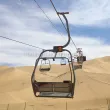Are Fixed chairlift Cableway safe?
Fixed chairlift cableways, commonly used in ski resorts and mountainous areas for transporting passengers up slopes, are generally considered safe when designed, installed, and operated according to established safety standards and regulations. However, as with any transportation system, safety depends on various factors and adherence to safety practices. Here are some key considerations regarding the safety of fixed chairlift cableways:
Regulatory Compliance:
Fixed chairlift cableways must comply with local and international regulations and standards established for ropeway systems. Regulatory bodies set guidelines for design, construction, operation, and maintenance to ensure safety.
Regular Inspections and Maintenance:
Routine inspections and maintenance are crucial for ensuring the safe operation of chairlifts. Regular checks on the cables, towers, chairs, drive systems, and safety features help identify and address potential issues before they become safety hazards.
Engineering and Design Standards:
The design and engineering of fixed chairlift cableways must adhere to industry standards. This includes factors such as load capacity, stability, materials used, and structural integrity. Compliance with recognized standards helps ensure a reliable and safe system.

Operator Training:
Operators responsible for managing and operating chairlifts should undergo thorough training. Proper training includes understanding emergency procedures, passenger evacuation protocols, and routine operational tasks. Well-trained operators contribute to safe and efficient chairlift operation.
Weather Monitoring:
Weather conditions can affect the safety of chairlift operation. Wind speed, in particular, is a critical factor. Chairlifts are designed with wind speed limits, and operators should monitor weather conditions closely. In adverse weather, chairlifts may be temporarily closed to ensure passenger safety.
Emergency Procedures:
Chairlifts are equipped with safety features and emergency systems. Passengers should be informed about proper behavior during emergencies, and operators should be trained to handle emergency situations effectively.
Passenger Behavior:
Safe chairlift operation also depends on passenger behavior. Passengers should follow instructions, remain seated during the ride, and use safety bars when provided. Proper behavior reduces the risk of accidents and injuries.
Communication Systems:
Effective communication systems between operators and passengers are essential. In the event of an emergency or operational issue, clear communication ensures that passengers are informed and can follow instructions for a safe response.
Regular Training and Drills:
Conducting regular training sessions and emergency drills helps operators and staff remain prepared for various scenarios. Practice drills for passenger evacuation and emergency response contribute to overall safety.
While fixed chairlift cableways can provide a safe means of transportation when operated according to industry standards, it is important for users to be aware of and follow safety guidelines. Additionally, regulatory bodies and operators play a crucial role in ensuring the ongoing safety of chairlift systems through adherence to standards, regular inspections, and effective training programs.


